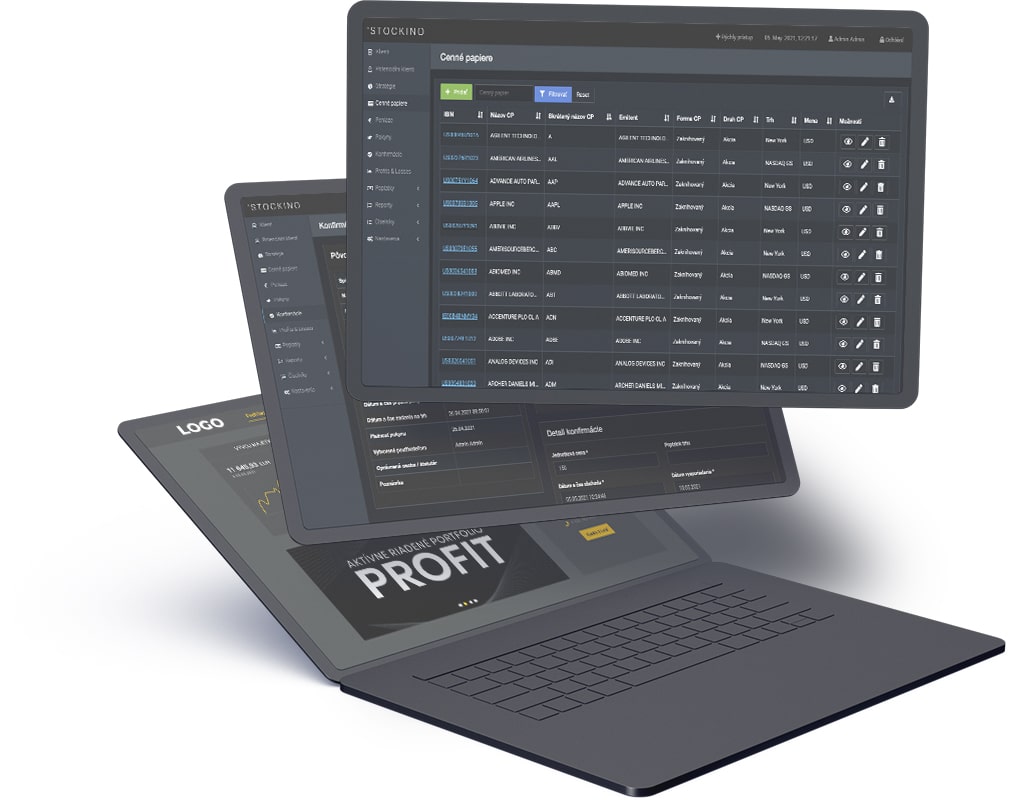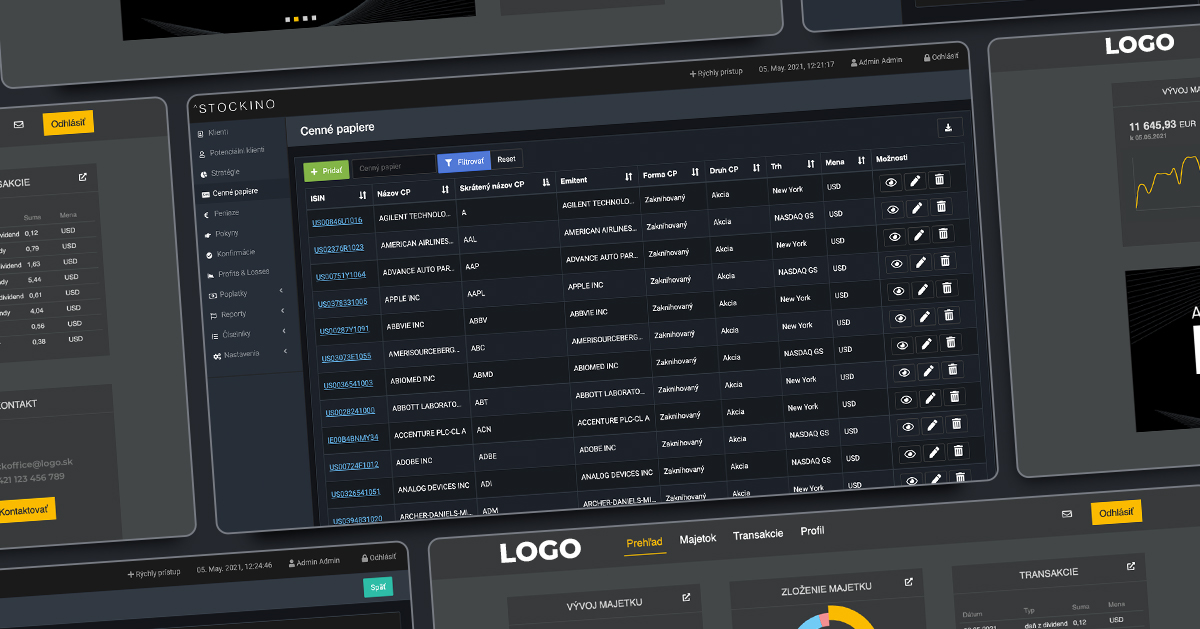Financial Information System Stockino
Registration software for securities traders

About Stockino
Stockino is a boxed solution, a software product aimed specifically at companies in this regulated industry, which meets all the demanding requirements of the National Bank. At the same time, it helps automate and digitalise financial companies' internal processes.
Our Expertise
Software Development
Scope
Discovery phase
Product development
Maintenance
Quality assurance
Vertical
Fintech
SaaS
Key results
- Modern financial information system with links to financial market data
- Can also be adapted to the specific requirements of companies
See what Altamira can do for you
01
The Challenge
Establishing a legal entity – a joint stock company or a securities trader is administratively demanding and brings several legislative obligations. Among other things, it also places demands on the software equipment of the company applying for a license.
Software for securities dealers or other financial companies subject to regulation must be inspected or audited by the National Bank of Slovakia before a license is granted. The inspection validates the fulfilment of the software’s mandatory requirements. It also verifies the ability of specific staff to work with the software to fulfil their legislative obligations.

02
The Solution
Financial information system Stockino is an open platform for stock traders. It works in a web browser environment in a cloud or even an on-premise environment. The choice of the solution itself – cloud vs. on-premise – reflects the security requirements.
All personal data is encrypted in the database, and all communication flows over a secure SSL protocol. However, some companies choose an on-premise solution for the high level of security. The software runs on servers exclusively within the internal network without an internet connection.
Stockino is a so-called closing system, i.e., the transaction data accumulated in the financial information system is consolidated to form daily closing totals. This makes the system fast, even when used for many years with millions of database rows. Reporting and data handling generally use daily, consolidated data, so there is no need to search the entire complex transaction database.
Modules
The supporting element and unifying entity of the whole financial information system is the Client and the Security, or Equity. Almost all other modules of the whole system are tied with these. Within the system, we record all the legally obligatory information about the clients and other necessary data and entities. This enables the management of the processes required.
Stockino comes with a myriad of modules in its base. They cover all the daily routine activities of financial companies and help cover the processes these companies need to have for their “seamless” operation.
- Financial accounts
- Property accounts
- Investment strategies
- Contracts
- Transactions
- Instructions
- Shops
- Securities
Investment strategies or portfolios
One of Stockino’s core modules is Investment Strategies. These are used to categorize clients while automating the bulk management of investment portfolios.
An Investment Strategy is a fully configurable entity containing selected assets and possibly a benchmark (e.g., S&P 500) against which the strategy’s performance is compared. With an active module for automatic trade calculation, Stockino also automates buying orders for several assets that correspond to the percentage ratios within a strategy while considering the state of the client’s financial accounts. Hence, there is a need to work with fractional stocks, i.e., fractions. Yes, Stockino is geared to the possibility of fractional trading.
Money, instructions, confirmations
Money, Orders, and Confirmations are important and interconnected modules for the placement, subsequent confirmation, and entry of orders into the market. In securities trading firms, responsibilities are generally split between the Front Office and Back Office. This also reflects the setup of user roles and responsibilities within Stockino. Entering buy or sell orders into the system is the user’s responsibility with the Front Office role. The actual confirmation and settlement of orders is usually the responsibility of another administrator – so four-eye control is maintained.
Order entry, validation, confirmation, market-entry, and settlement are all very complex screens with many validations and automated checks tied to them. Automated validation aims to prevent potential errors while generating high-quality data in the financial information system so that subsequent reporting to regulators is seamless.
In securities trading companies, responsibilities are usually divided between Front Office and Back Office, reflecting the setup of user roles and responsibilities within Stockino.
Reporting
Stockino includes a comprehensive reporting module allowing you to look at company-wide data from various perspectives. Besides the legally required reports – e.g., reporting for the National Bank of Slovakia or ESMA reporting dozens of other internal reports are available. These are used for clients and internal needs (e.g., reports on deposits, trades, orders). Many reports are automated, and the outputs are sent to their expected clients or system administrators at set intervals.
Stockino also includes several internal “triggers” that generate a report or at least a notification. Part of this is the so-called AML – Anti-Money Laundering report. The reports are often programmed to a specific customer, as they can develop their view of the data that the company collects.
P&L or Profit & Losses
P&L is a standalone Stockino plugin, a comprehensive module for tracking the performance of individual portfolios or entire investment strategies. It contains a complex mathematical model to calculate portfolio value.
Stockino also includes several internal “triggers” that generate a report or at least a notification. Part of this is the so-called AML – Anti-Money Laundering report. The reports are often programmed to a specific customer, as they can develop their view of the data that the company collects.
Strive for excellence with Altamira
Join our community of successful customers, whom we helped to build and grow their businesses.
Pricing policy
Stockino is a software with a simple EULA licensing pricing policy, where the base price consists of two components
- software installation fee, including some workdays required to customise the system or migrate data from other software
- a monthly license fee, considering the number and nature of the modules used.
Due to the regulatory requirements of the NBS, each securities trader’s license holder must also have a valid SLA (Service Level Agreement) contract, by which the software operator guarantees the client response times and service conditions. This agreement is a priced component of the monthly license fee and does not increase the financial cost of operation.
Digital onboarding and client zones
Stockino also includes outputs for clients of financial companies and tools for their digital onboarding, linked directly to the core financial information system. Digital onboarding is a topic that has accelerated the pandemic situation. The pressure to digitalise companies’ processes has increased precisely because of the limited opportunities for face-to-face meetings.
It enables a person to become a financial institution client without visiting a branch. The solution can include facial biometrics, i.e., verifying the client’s identity and digitally signing contractual documentation via a tablet or smartphone. As part of onboarding, the client goes through the steps required by legislation, such as a mandatory investment questionnaire and a commercial questionnaire used to discover the client’s investment intentions or preferences.
Stockino’s digital onboarding is a legislated 100% compliant process
The client zone is the next logical step of the “onboarded” client, within which the user is given access to their data. In real-time, they can view their financial or asset account balances, enter instructions to buy or sell assets, and deposit or withdraw funds.
The client also has access to contractual documentation and reports in the message centre in the client area, which securities traders can generate on request. The client zone is delivered as a white-label solution. It is fully customisable to the visual identity of the specific trader to complement all of the company’s visual outputs consistently.
Besides clients’ access to their data, the client zone also allows brokers/dealers access to their clients’ data. This makes their work very transparent and allows them to maintain control over the status of the client portals. This access to the client zone for intermediaries can be integrated into intermediaries’ existing CRM solutions using APIs. This allows them to service clients under one roof without leaving their CRM application.
03
The Result
Stockino is a modern financial information system with a modular architecture with links to financial market data. It enables out-of-the-box operations for newly established financial companies to shape their processes. Thanks to its open architecture, Stockino’s processes can also be adapted to the specific requirements of companies established on the market for a long time.
The collaboration of several securities traders created Stockino. Its goal is to build a long-term market standard and become a leader in software for financial institutions, wealth management companies, securities traders, asset managers, or other institutions managing their clients’ assets.
Case Studies

